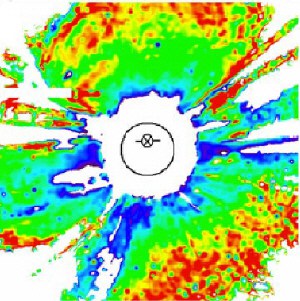Violent explosions on the Sun known as coronal mass ejections can have a major impact on the Earth by disrupting telecommunications systems and causing power cuts. The "space weather" caused by these events can also expose astronauts and spacecraft to high doses of radiation. Now, two solar physicists at NASA have used measurements of polarization to produce the first three-dimensional reconstructions of coronal mass ejections (CMEs). The results could lead to a better understanding of the causes and effects of space weather (T Moran and J Davila 2004 Sciencexpress 1098937).

CMEs are the most energetic explosions in the solar system. They begin close to the surface of the Sun and then expand to propel tens of billions of tons of matter — mostly hydrogen and helium — into space at speeds of millions of kilometres per hour. Thomas Moran and Joseph Davila of the Goddard Space Flight Center measured the ratio of polarized to unpolarized light from coronal emissions, and then combined this data with data on the total brightness to reconstruct the CME in three dimensions. They used data from the LASCO instrument on board the Solar and Heliospheric Observatory (SOHO), which was launched in 1995.
The NASA duo imaged both loop and halo CMEs. A loop CME provides a side view of an eruption, while a halo provides a front or rear view. They found that loop CMEs show a complex three-dimensional structure, centred at 40 degrees from the plane of the sky, and move in a radial direction with a speed of 250 kilometres per second. Halo CMEs, on the other hand, have a bilateral symmetry, which suggests they are expanding arcades of multiple loops (see figures).
“Besides understanding the structure and origin of CMEs, the new 3D imaging technique may lead to better predictions of arrival times and impact angles at the Earth,” Moran told PhysicsWeb. “This may help in planning protective measures for satellites and astronauts.”
The physicists plan to analyse more data from LASCO, and also hope to repeat their experiments with the STEREO mission, which NASA plans to launch in 2006. “STEREO will launch two identical spacecraft to image the Sun and will use both polarization and tomography methods, which will provide more information than either method separately,” said Moran.





